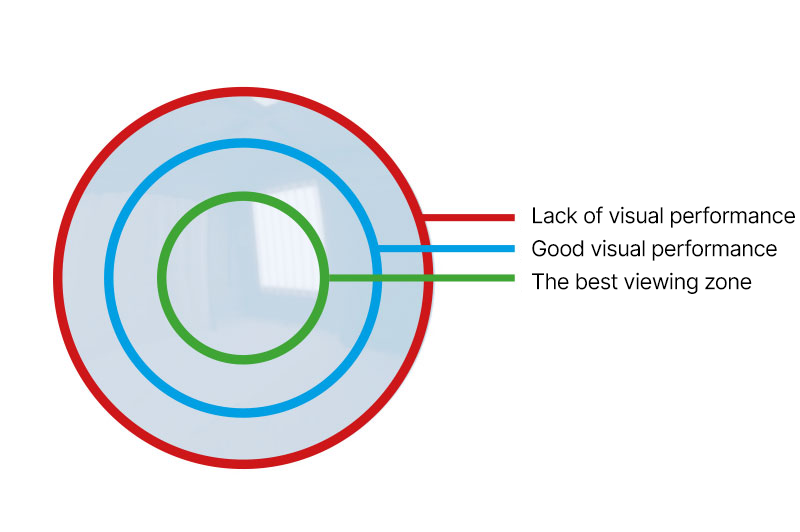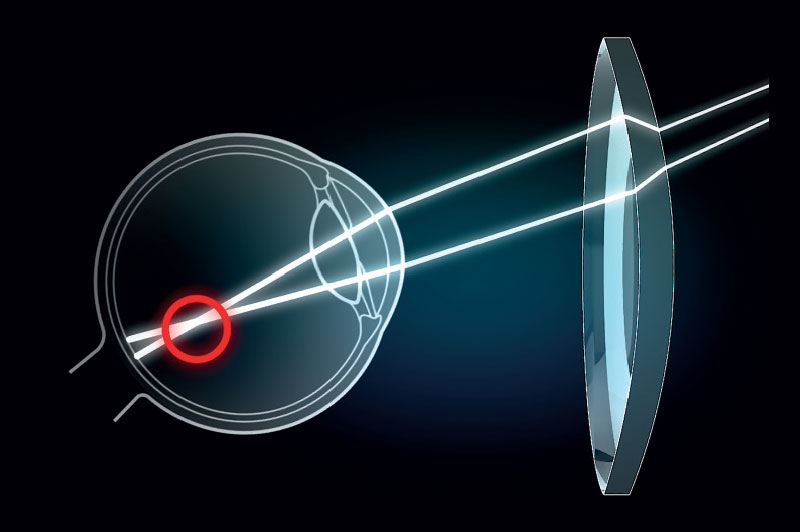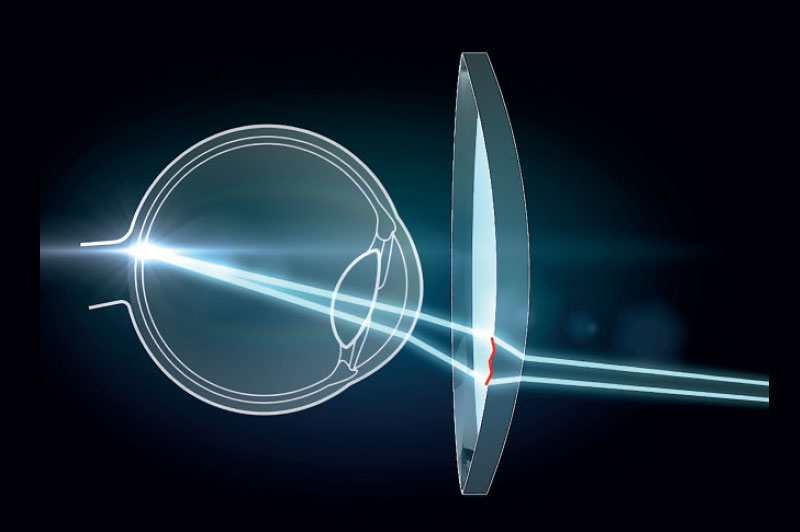Single-vision lenses by Wetzlich
Single-vision lenses with maximum precision & innovation, made in Germany. Customised lenses for sharp vision at near and far distances.
Single-Vision Lenses by Wetzlich –
Quality from Germany
Single-vision lenses are defined as lenses with a single visual area over the entire lens surface.
They correct either short-sightedness (myopia), long-sightedness (hyperopia) or astigmatism.
Single-vision lenses and single-vision lenses with near addition are ideal for younger people who need vision correction for either distance or near vision.
With the onset of presbyopia (from around the age of 40), progressive lenses are generally the better choice, as they enable continuous vision at all distances.
Single-vision lenses by Wetzlich – at your local optician:
The following types of ametropia can be corrected with single-vision lenses and give you razor-sharp vision again:
Myopia
Myopia is a weakness of the eye. In a short-sighted eye, the focal point (the point where the light rays meet again – i.e. where the image is formed) is in front of the retina. In a normal eye, this focal point would lie directly on the retina and thus produce sharp vision. The result is an aberration that makes nearby objects appear sharper than those further away. Hence the term short-sightedness. Short-sightedness is determined and identified by an eye examination (refraction) with an optician or ophthalmologist. It is specified in dioptres (unit of measurement for refractive power). On your spectacle prescription, you will find information about myopia under the abbreviation: sph (sphere). This value is negative for short-sighted spectacle wearers.
Causes of Myopia
- Axis myopia: The eyeball is too long. As the image is focused in front of the retina and then dispersed, vision is blurred.
- Refractive myopia: It is also possible that the refractive power of the lens system of the eye (cornea, lens) is too strong. This then causes the image to appear in front of the retina, as in axial myopia.

Hyperopia
Long-sightedness (or hyperopia) is similar to myopia in that it is a weakness of the eye. In a long-sighted eye, however, the focal point lies behind the retina, so that in the relaxed state of the eye everything looks blurred. The eye can compensate for this to a certain extent by tensing the lens in the eye.
Just like myopia, there are two different causes:
- Axis hyperopia: The eyeball is too short, therefore the light meets behind the retina and creates a blurred image (the opposite to myopia)
- Refractive hyperopia: In rare cases, the refractive power of the eye’s lens system is too weak (again in contrast to myopia).

Astigmatism
Astigmatism is a deformation of the cornea. In contrast to myopia and hyperopia, the length or shortness of the eyeball is not relevant here. The curvature of the cornea is not uniform, but has a dent in it. As a result, the light cannot be refracted properly and does not meet on the retina to form a point, but rather a rod shape. “Astigmatism” is derived from the words “A” for “not” and “stigma” for “point”. The translation would then be: “not at one point”.
How do I notice astigmatism?
Astigmatism can manifest itself in different ways. Here are the most common signs and symptoms that may indicate this:
Typical symptoms of astigmatism:
Blurred or distorted vision – both far and near.
Light sources appear distorted or with ‘rays’ – e.g. streetlights at night.
Headaches – especially after prolonged reading or working at a screen.
Rapid eye fatigue – when reading, working at a computer or other activities that require concentration on details.
Frequent blinking or squinting of the eyes to see more clearly.
Difficulty seeing at dusk or at night.
Quality Lenses – a Difference You Can See
In addition to distortions towards the edges, spherical lenses have a significantly higher inherent magnification or, in the case of minus lenses, reduction in size. You can reduce these defects with modern aspheric or multi-aspheric glasses.
Our multi-aspheric single-vision lenses:
Weviline, Weviline Plus, Signature 2.0, Signature 2.0 Plus
Our indiviudual single vision lenses:
Trinity, Trinity Plus

- Multi-aspherical design
- Modern entry-level lens for simple strengths

- Multi-aspherical design
- Stable field of vision with minimal edge distortions
- Ideal for higher cylinders and contact lens wearers
- Customisable to your needs

- Perfect imaging in all fields of vision, multi-aspherical design
- Ideal for high dioptre values
- Aesthetic result for the highest demands
- Based on Digital-Ray-Path® technology
- High degree of customisation to your needs
Wetzlich single-vision lenses can be customised with many lens options (depending on the quality level).
Opticians can find more information in our product catalogue – to the catalogue.
Spherical Lenses
- Wearing comfort:
thicker & weightier lenses - Visual quality:
distortions at the edge

Aspherical Lenses
- Medium Comfort Level:
thinner & flatter lenses - Average Visual Quality:
less distortion at the edges

Multi-Aspherical Lenses
- Optimised Wearing Comfort:
even thinner & more natural in appearance - Very good visual quality:
no edge distortion - High visual performance:
ideal for high dioptre values

Single-Vision Lenses with Digital Ray-Path® Technology
How do you achieve optimal vision at every single point of the lens? Non-optimised lenses have restrictions for the wearer on the periphery, i.e. on the outer edge of the lens. In addition, the image deteriorates as soon as you look through a lens at an angle, because conventional lenses are not optimised for the wearer at every point.
Digital Ray-Path technology simulates how our gaze moves on the basis of the frame shape and individual parameters and adapts every point of the lens to the wearing situation.
Our single-vision lenses with Digital Ray-Path technology: Trinity, Trinity Plus.



Single-Vision Lenses With Near Vision Support
As a result of the complete integration of mobile devices (smartphones, tablets) into everyday life, a perfect view of your surroundings is becoming more and more important. Since human beings are naturally designed to see better at a distance than at close range, consideration, should be given at an early stage to near vision support in the lens.
Single-vision lenses with close-up support are also aimed at the target group of 30 to 45-year-olds. A majority of this target group works several hours a day at a PC and suffers from eye fatigue. In addition, they must deal with various strains that did not exist in the past, such as reading long texts on a smartphone.

Close-up vision, e.g. with digital devices, becomes blurred.

Clear vision – even at close range, thanks to the close-up range in the single vision lens.

Clear vision – even at close range, thanks to the close-up range in the single-vision lens, plus contrast enhancement with UV420 Eagle Eyes.

- Without proximity support
- Multi-aspherical design
- Classic entry-level product for simple strengths in the field of young presbyopia
- Increased performance through fatigue-free vision in all fields of vision

- Without proximity support
- Multi-aspherical design
- Ideal for 30-45 year olds who spend a lot of time working at close range

- Without proximity support
- Multi-aspherical design
- Optimal support of seeing movement
- Based on Digital-Ray-Path® technology
- Consideration of individual parameters
Do you have any questions about our single-vision lenses or any other concerns?
FAQ – Single-Vision Lenses
Who should consider single vision lenses? When is the best time to start using them? And which visual impairments can be corrected with them? Questions upon questions – we will give you the answers.
Wetzlich single-vision lenses are manufactured in Germany. You can find out more about our production in Korschenbroich here: Production of lenses
What are single vision lenses?
Single vision lenses are lenses that have the same visual acuity over the entire surface. They are used when a uniform correction of defective vision is required – whether near or far. These lenses are ideal for people with short-sightedness, long-sightedness or astigmatism.
When do you need single vision glasses?
Single-vision glasses are required if only one range of vision – either for near vision (e.g. when reading) or distance vision (e.g. when driving) – needs to be corrected. Single-vision lenses are also a common solution for the first signs of visual impairment, for example in schoolchildren or with the onset of presbyopia.
Are single vision lenses only for younger people?
In principle, single vision lenses are suitable for all ages – they correct either near or distance vision. With the onset of presbyopia, however, it is advisable to switch to progressive lenses, as these enable continuous, comfortable vision at all distances – without the need to constantly change glasses in everyday life.
What is the difference between single vision and multifocal lenses?
The main difference lies in the number of visual ranges: single vision lenses have a uniform range, while multifocal lenses (e.g. progressive lenses) combine several visual ranges – near, intermediate and distance – in one lens. Multifocal lenses are useful if you want to cover several distances with one pair of glasses. Ideally, progressive lenses should be used from the onset of presbyopia (from around 40 years of age).
Are single vision lenses suitable for correcting astigmatism?
Yes, single vision lenses can effectively compensate for astigmatism. In this case, so-called cylindrical values are incorporated into the lens to correct the uneven refractive power of the cornea and enable clear vision.
Which visual defects can be corrected with single vision lenses?
Single-vision lenses are suitable for correcting short-sightedness (myopia), long-sightedness (hyperopia) and astigmatism. They ensure that the image is displayed sharply on the retina again – whether near or far.
What is the disadvantage of buying single vision lenses online?
Buying single vision lenses online can be problematic if the vision values are outdated or inaccurately measured. Without professional advice and exact measurements from an optician, there is a risk that the lenses will not be optimally made for your needs and fitted to your glasses – which can lead to headaches, blurred vision or rapid fatigue. It is therefore essential that you seek advice from an optician with Wetzlich lenses in your area.

About Wetzlich
We have been manufacturing lenses with the highest precision and innovative strength in Germany since 1935.
We not only ensure that you simply see better and more with our products. For years we have been developing lenses that provide optimum protection for your eyes. This includes e. g. our UV and infrared protection coating as well as innovative lens materials that filter blue light and increase contrasts.
With one of the most modern European machine setups, we stand for advanced products with the highest quality standards at fair prices.
You can purchase WETZLICH lenses from your local optician. Simply ask him about our lenses or find a WETZLICH partner optician in our optician search.

